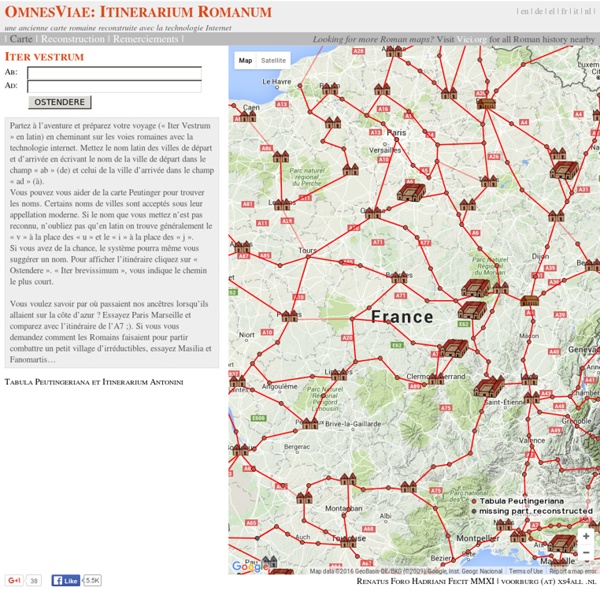



The Agas Map Our new (as of the beginning of 2015) implementation of the Agas Map is based on the OpenLayers 3.0 library. It presents the map as a zoomable, rotatable tiled image with several hundred locations plotted on it. In the default view, the locations are initially hidden; you can show them by checking checkboxes in the navigation panel which appears at the top right of the map. Locations in the navigation panel are sorted into categories; click on a category name to expand it and see all the locations. Some locations appear in more than one category.
Données publiques ouvertes, les réutilisations du MENESR Depuis le 24 avril 2014, le Ministère de l’Éducation nationale, de l’Enseignement supérieur et de la Recherche (MENESR) anime la première plate-forme Open Data ministérielle. Pour faciliter la mise à disposition de ses données sur l’enseignement supérieur et la recherche, le MENESR s’est associé à OpenDataSoft, dont les performances techniques ont facilité l’ouverture des données publiques. Extrait du dossier de presse réalisé pour l’ouverture de la plateforme Open Data Enseignement supérieur et Recherche : “Le ministère a choisi la jeune start-up française OpenDataSoft, spécialisée dans le traitement et la publication de données en ligne, pour la mise en œuvre de son service d’accès aux données libres sur l’enseignement supérieur et la recherche. Performance technique, ergonomie, facilité de déploiement et maîtrise des coûts sont à l’origine de ce choix.” Chez OpenDataSoft, une de nos missions est d’optimiser la diffusion, l’accès et la réutilisation des données.
Interactive: When Do Americans Leave For Work? JavaScript required for interaction.<br /><img src=" In a continued dig into commute data from the American Community Survey (We already saw mode of transportation.), the map above shows when people leave home for work. The rates are for people who have jobs and are 16 years or older. The data does not include people who work from home.
Cartography of the Anthropocene - Globaïa The Anthropocene: A primer. The Anthropocene. We’re already there. This is our time, our creation, our challenge. Officially, this epoch does not exist. Yet. The Marauders Map I was watching Harry Potter and the Prisoner of Azkaban last night and it occurred to me that I still haven't seen a good interactive version of the Marauders Map. I had a couple of hours free this morning so I decided to give it a go. I'm not entirely happy with my Marauders Map but I thought I'd share it any way. The Geotagger's World Atlas Every city has something unique about it, whether it’s a memorial statue, a cool coffee shop, a world-renowned museum or a local pizza parlor. These places are visited by hundreds or maybe even thousands of people a year, which translates to dozens of photos, many of which are geotagged to show the location of these popular and special places. So, what would happen if you took all of those photos and created a map, linking the photos to show individual journeys and locations? Well, you would end up a neat sketch-like image of the location, filled with individual travels and popular locations. You’d get the Geotagger’s World Atlas.
Mapline Blog How to Make an Awesome Data Visualization with Pin Map What is a Pin Map? 1 location = 1 pin Got the idea? Therefore, a pin map contains pins that each represent a geographical location. I-Map: Common Outputs Interactive Map of Irregular and Mixed Migration Routes in the Budapest Process, Mediterranean Transit Migration Dialogue and Prague Process Regions This interactive map is a common output of the BP, MTM and PP. It was elaborated on the basis of the 2012 MTM Map on Irregular and Mixed Migration Routes, the 2010 Prague Process "Building Migration Partnerships" Map on Illegal Migration Routes and the 2013 Mapping of Migration Routes in the Silk Route Region.
Choose the right chart for your data with this tool Credit: Screenshot of the 'Essentials' chart choosing resource. Data visualisations can pack a lot of information into one element of a story, helping you effectively illustrate long-term trends, percentages or other comparisons. But using the wrong type of chart for your data can result in misrepresented numbers and misleading your audience. MapBox le logiciel de cartographie MapBox est un logiciel Open Source, plateforme pour créer et utiliser des cartes. Il s’agit d’un ensemble d’outils et de services. On peut dessiner une carte avec MapBox Editor ou construire une application pour Android ou iPhone. Free mapping data will elevate flood risk knowledge For the past 17 years we have been capturing LIDAR (Light Detection & Ranging) data in England. LIDAR uses a laser to scan and map the landscape from above and is widely considered to be the best method for collecting very dense and accurate elevation data across the landscape. We use LIDAR to help the work of the Environment Agency in many ways, including creating flood models, assessing coastal change and analysing how land is used. We now have an extensive archive of aerial LIDAR data covering nearly three quarters (72%) of England – the data mainly covers flood plains, coastal zones and urban areas. As technology has improved and costs have fallen, LIDAR data is now being used by just about everybody who works with maps. From local planners to archaeologists, farmers to ecologists, LIDAR data can inform their work.